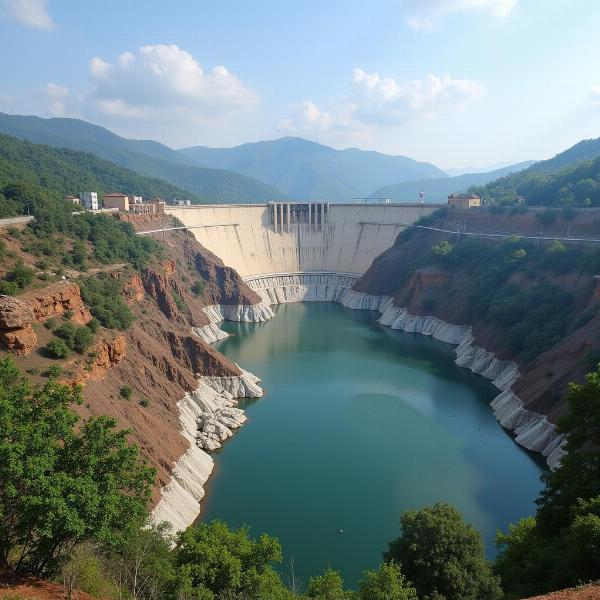Hydroelectric power, a cornerstone of renewable energy, plays a vital role in India’s energy landscape. Understanding the “hydroelectric meaning in Hindi” is crucial for anyone interested in sustainable energy solutions. This article will delve into the meaning, significance, and various aspects of hydroelectric power, particularly within the Indian context.
Understanding “Hydroelectric” in Hindi
The Hindi term for hydroelectric is “जलविद्युत” (jalvidyut). This term is a combination of two words: “जल” (jal) meaning water, and “विद्युत” (vidyut) meaning electricity. Therefore, “jalvidyut” literally translates to “water electricity,” accurately capturing the essence of hydroelectric power generation. This simple yet powerful term reflects the process of harnessing the energy of flowing water to produce electricity.
How Hydroelectric Power Works
Hydroelectric power generation relies on the conversion of potential energy stored in water, typically at a higher elevation, into kinetic energy. This conversion happens when water flows downwards and drives turbines connected to generators. These generators then convert the mechanical energy into electrical energy. The process is clean and sustainable, utilizing a naturally replenishing resource: water.
The Importance of Hydroelectricity in India
India, with its diverse geographical features, including numerous rivers and mountainous regions, possesses significant hydroelectric potential. Hydroelectric power offers a cleaner alternative to fossil fuels, contributing to reduced carbon emissions and a cleaner environment. It plays a crucial role in meeting India’s growing energy demands and supporting its economic development.
 Hydroelectric Dam in India
Hydroelectric Dam in India
Types of Hydroelectric Power Plants
Hydroelectric power plants can be categorized based on their size and operational characteristics:
- Large Hydro: These plants typically involve large dams and reservoirs, generating substantial amounts of electricity.
- Small Hydro: Smaller-scale projects, often utilizing natural water flow without large dams, are suitable for localized power generation.
- Run-of-river: These plants harness the natural flow of rivers without the need for large storage reservoirs.
- Pumped Storage: These plants utilize two reservoirs at different elevations, pumping water uphill during periods of low demand and releasing it during peak demand to generate electricity.
Benefits of Hydroelectric Power
The advantages of hydroelectric power are numerous, including:
- Renewable and Sustainable: Hydropower relies on the water cycle, a naturally replenishing resource.
- Clean Energy Source: It produces no greenhouse gas emissions during operation.
- Reliable and Efficient: Hydroelectric plants provide a stable and predictable source of electricity.
- Cost-Effective: While initial investment costs are high, the long-term operational costs are relatively low.
Challenges and Considerations
Despite the benefits, hydroelectric projects also face challenges:
- Environmental Impact: Large dams can alter river ecosystems and displace communities.
- Social and Economic Impacts: Project development can lead to the relocation of people and impact local livelihoods.
- Water Availability: Droughts and changing precipitation patterns can affect power generation.
Hydroelectric Power and Sustainable Development
Hydroelectric power can play a crucial role in achieving sustainable development goals by providing clean energy, supporting economic growth, and promoting environmental conservation. However, careful planning and consideration of environmental and social impacts are essential for responsible hydropower development.
What are the key components of a hydroelectric power plant?
The main components include the dam, reservoir, intake, penstock, turbine, generator, and power lines.
Is hydroelectric power truly a clean energy source?
While hydroelectricity produces no direct greenhouse gas emissions during operation, the construction of dams and reservoirs can have environmental impacts that need careful consideration.
What is the future of hydroelectric power in India?
India continues to explore its vast hydroelectric potential with a focus on sustainable development and minimizing environmental impacts.
Conclusion
Hydroelectric power, or “jalvidyut,” offers a significant pathway towards a cleaner and more sustainable energy future for India. Understanding its meaning and implications is essential for fostering informed discussions and promoting responsible development of this vital resource.
FAQs
- What is the meaning of “hydroelectric” in Hindi? The Hindi term for hydroelectric is “जलविद्युत” (jalvidyut), meaning “water electricity.”
- Why is hydroelectric power important for India? It provides a clean and renewable energy source, contributing to reduced carbon emissions and meeting growing energy demands.
- What are the different types of hydroelectric power plants? Large hydro, small hydro, run-of-river, and pumped storage.
- What are the environmental impacts of hydroelectric projects? Large dams can alter river ecosystems and displace communities.
- How does hydroelectric power contribute to sustainable development? It offers clean energy, supports economic growth, and promotes environmental conservation.
Meaning-Hindi.in is your trusted partner for high-quality Hindi translation services. We specialize in a wide range of translation solutions, including business and commercial documents, legal and certified translations, technical manuals, website localization, educational materials, and specialized industry translations. Our team of expert linguists ensures accurate and culturally sensitive translations to meet your specific needs. For reliable and professional Hindi translation services, contact us at [email protected] or call us at +91 11-4502-7584. Meaning-Hindi.in is committed to bridging language barriers and facilitating effective communication.